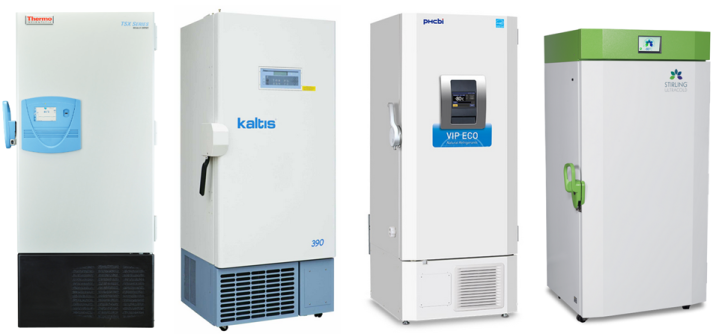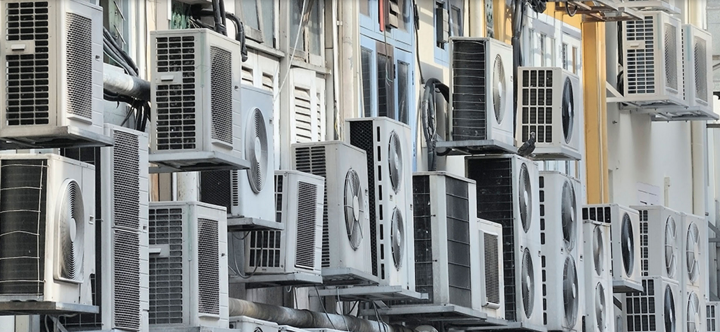Project Drawdown brought together experts in several fields to come up with a ranked list of solutions to climate change and, somewhat surprisingly, refrigerant management was #1 on that list. This applies mostly to air conditioning (AC) units and any form of freezer/refrigerator. Starting in 1989, under the Montreal Protocol to reverse damage to the ozone layer, chlorofluorocarbons (CFCs) were phased out as refrigerants and largely replaced with hydrofluorocarbons (HFCs). Although less damaging to the ozone layer, HFC refrigerants have very high global warming potentials (GWPs) – several thousand-fold higher than that of CO2.
So what does refrigerant management mean? I’ll break it down into three categories, in each case looking at ways in which consumers can make positive choices at home and at work.
1. Switching to sustainable refrigerants
25 years ago, Greenpeace took unprecedented action to deal our atmospheric crises: they did their own R&D to develop a refrigerant that was ozone-friendly and also had a much lower GWP. The new refrigerant, which they called GreenFreeze, used a combination of simple hydrocarbons (no chlorine or fluorine): isobutane (R600a) and propane (R290). They used cyclopentane for blowing the insulation foam in case you were wondering. (Tossing and turning all night: but what was the blowing agent for the insulation foam? Why list the refrigerants but not the BA? What was it?!) In any case, within just a few years the refrigerant was widely adopted and Greenpeace received an award from the UN for making GreenFreeze open-source and freely available. Keep that in mind, particularly if you imagine Greenpeace as nothing more than a bunch of trouble-making hippies.
What are the most promising eco-friendly refrigerants?
R290 (propane) still appears to be one of the best choices as an eco-friendly refrigerant. In 2017, some clever researchers started with all 156 million chemicals in the PubChem database and screened for those that had suitable properties as refrigerants, combined with low toxicity and low GWP. Propane (R-290), ethane (R-170) and ammonia (R-717) were confirmed in a short list of the most promising alternatives to HFCs. Ammonia isn’t so common yet, but it does work: for example, Azane makes ammonia-based chillers.
Buying a more sustainable freezer for your workplace
If you happen to work in a place where freezers are used (labs, hospitals, food industry, etc.) then there are now a few options for avoiding HFCs and also reducing energy consumption. For ultra-low temperature (-80°C), both Thermo Scientific’s TSX freezers and Panasonic’s VIP ECO freezers use hydrocarbon refrigerants, propane (R-290) and ethane (R-170), and also consume less energy during operation. Kaltis and Stirling also sell -80°C freezers that contain hydrocarbon refrigerants, while Inomak and True make -20°C freezers for the food industry that use propane (R-290) as refrigerant.

Choosing a sustainable fridge/freezer for your home
Here’s a quick guide to some fridge/freezer makers that have moved away from HFC refrigerants. LG should also be on that list, having switched to isobutane (R600a) in all of their models. I dealt with LG before in a couple of posts on cell phones, and consider them a pretty good choice (over Samsung, for example).
For AC units, your best bet is to search online for information about models that contain R290 (or other low-impact refrigerants). For example, someone asked this question on Quora for models available in India.
2. Preventing refrigerant leaks during use
The second aspect of refrigerant management is to be aware of the consequences of (high GWP) refrigerant leaks from AC units and freezers. A couple of points from the EPA:
A leak of 1 kg of refrigerant causes about the same environmental damage as driving a van 10,000 miles.
It is illegal to top up a system with refrigerant without first finding and repairing the leak(s).
This is especially true for AC systems, which generally run on R22, a hydrochlorofluorocarbon (HCFC) with a GWP of 1810 (i.e., almost two thousand times more potent than CO2). If you detect a chemical odor from your fridge or AC unit, it may be a refrigerant leak. You may also see an oily residue on the floor (a by-product of the leak; the refrigerant itself is a colorless gas) or notice that your freezer or AC unit it not working well (e.g., a freezer that’s running almost all the time). You can find the leak yourself using an electronic leak detector or old-fashioned soapy water (making sure it’s unplugged in that case) or otherwise call a professional. In labs and hospitals, leak testing should be done on an institute-wide level – you can check with your Environment, Health & Safety Dept. to see if this is happening in your workplace.
3. Correct disposal of refrigerants
The third aspect of refrigeration management is end-of-life: how to dispose of your old AC unit or freezer. As you can imagine, the key is to dispose of any old AC units or fridge/freezers through a channel that correctly recycles or destroys the refrigerant. This is particularly an issue in China, which accounts for 46% of AC units in use globally. A paper published just last month reveals that mismanagement of refrigerants (especially at disposal) in China is a large contributor to greenhouse gas emissions (projected to reach levels equivalent to the entire 2015 GHG emissions for The Netherlands). So, if you own an old AC unit (or freezer), make sure it’s disposed of properly! Check with the manufacturer for take-back programs, or with your local authority. Thankfully, China (who manufactures 62% of global AC units) is projected to move towards using R-290 (propane) for new units. I guess we have Greenpeace to thank for that!


Fabulous
LikeLiked by 1 person
I just love that Greenpeace is doing what they can to expand their reach to help the environment– and keeping it open source. Makes my heart warm and fuzzy.
LikeLiked by 1 person
Yeah – that contribution alone has made a significant difference. 40 years ago they were seen as extreme but a lot has changed since then!
LikeLike
Yes, I remember hearing jokes about them growing up. Any person thought to care “too much” was called a tree-hugger or one of those Greenpeace people. #hippiesareheros
LikeLiked by 1 person
I remember when CFCs were a big deal, and would check all my aerosol/cannisters if they were CFC free. I never thought about refrigeration as an area for concern. My mom prefers the old big white refrigerators than the moderns one now. But I will definitely keep in mind about appliances and how they play a role in the environment.
LikeLiked by 1 person
Yeah – HFCs and HCFCs are the new CFCs! (The F is fluorine.)
Thanks for reading and keeping it in mind!
LikeLiked by 1 person
wonderful encouragement
to protect this planet 🙂
LikeLiked by 1 person
I always feel that with our level of technology, humans are more than capable of coming up with better, greener solution! The focus just has to be shifted away from profiting to sustainable profiting. Thanks for another very informative post!
LikeLiked by 1 person
Well said, Julie! Thanks for reading. For other readers, here’s a link to Julie’s post on low-carbon ways of staying cool: https://darkbluejournal.com/10-tips-to-keep-cool-with-a-lower-carbon-footprint/
LikeLiked by 1 person